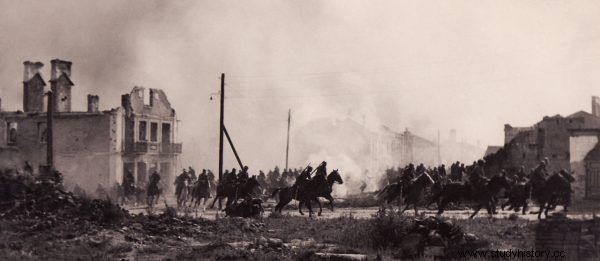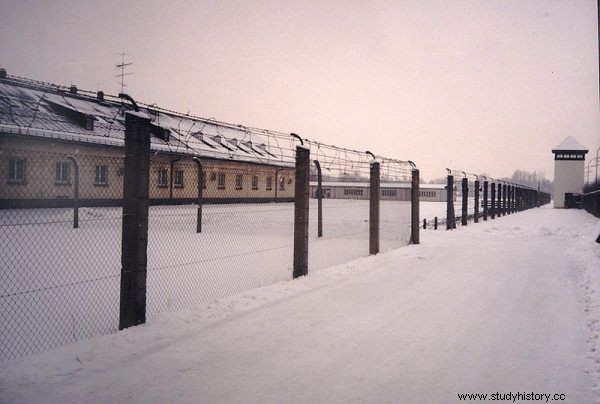Before World War II, the military could call on about 250 priests. In September 1939, however, thanks to the influx of volunteers, many more appeared at the front. How many exactly and what was their fate?
"In Poland, priests in the army are nothing new," writes Stanisław Zasada in the book " Duch 44. Strength beyond weakness " ". - In the Middle Ages, the knights sang the Mother of God before fighting, and the leaders were always accompanied by clergy. By no means were they just for celebrating church services, ”adds the author.
In the Second Polish Republic, the Field Bishop's Curia had its own network of parishes and published its own magazines. Until the last moment before the outbreak of the war, she was also recruiting for vacant chaplain positions. According to the assumptions of the time, each army - for example, "Modlin" or "Poznań" - should have had its own clergy. They were headed by a dean with the rank of colonel or lieutenant colonel.
Each brigade or division had its own parish priest, usually with the rank of major. He was subordinate to chaplains serving with individual infantry and cavalry regiments. All military hospitals and independent operational groups should also have separate priests. Another dozen priests worked in the field curia.
Prewar guidelines and chapels in suitcases
What did you have to do to become a chaplain in the pre-war army? You should be no more than 35 years old and have at least three years of priesthood practice. A positive opinion of the bishop or religious superior was also required.

To become a chaplain in the Polish Army, a number of rules had to be met. In the photo from the left, Fr. Jan Ziółkowski and Fr. Mateusz Zabłocki - senior chaplains of the Polish Army.
The service of military priests was not easy. In the event of the outbreak of war, they had to confess hundreds or even thousands of soldiers, take oaths, administer the last rites, and organize funerals. The regulations also provided for service in hospitals and presence during any executions. In addition, during the marches, the troops were obliged to celebrate mass regularly and to deliver "short and firm sermons". Therefore, they wanted them to maintain the morale of the soldiers.
The service did not end with the sacraments. The tasks of the clergy also included running field offices. Among other things, they filled in files concerning the fallen. They also looked after the graves of soldiers.
In order to make it easier for the priests to fulfill their duties, the curia tried to provide them with the appropriate equipment. Even before the war, modern field chapels with full liturgical equipment were purchased. They were carried in special suitcases and constructed in such a way that they could be quickly folded and unfolded. In addition to these "chapel cases", the priest accompanying the army also had a chest for office files. Added to this were a uniform, cassock and personal belongings. No wonder that each clergyman had his own horse-drawn cart to transport this considerable luggage in accordance with the instructions.
Special canonical regulations were in force since the announcement of the general mobilization of chaplains. In a situation where the missal and liturgical chalices were not available at the front, these priests had the right to say mass from memory, and therefore not necessarily exactly. They were also allowed to use ordinary glass vessels. Instead of the breviary in the field, they could say other prayers, such as the rosary. In addition, they were allowed to say three masses a day and to distribute communion immediately after meals (usually fasting). In the event of imminent death, they gave general absolution using a special abbreviated formula.
Absolution first
Of course, in the reality of the September campaign, even such flexible regulations often turned out to be of little use. In the midst of the turmoil of war, the priests had to deal differently.
First of all, the late mobilization meant that many chaplains did not manage to find their units. Ultimately, they simply joined troops without a priest. Additional priests soon joined the army. They volunteered, although they had not been called before. A Krakow professor of philosophy, priest Jan Salamucha, for example, showed up at the recruiting office in Warsaw and was referred to Fort Bema. Two diocesan priests from Poznań, Michał Kosicki and Marian Konopiński, put themselves at the disposal of the Greater Poland Cavalry Brigade, which did not have its own priests at that time. The same happened in other cities.
The clergy also struggled with many problems with the transport of equipment. This was the case with Father Franciszek Rinwalski, for example. “With a heavy field chapel, I went to Praga to the Paderewski Park in search of some kind of locomotion to join the Corps Command. I spent day and night in the park to no avail. Who will provide the chaplain with locomotion? " - he described his mobilization.

The Greater Poland Cavalry Brigade was a large cavalry unit of the Polish Army of the Second Republic of Poland. Only temporarily, it did not have chaplains, because volunteer priests came quickly. The photo shows WBK galloping through Sochaczew (1939).
After the outbreak of the war, it also turned out that it was practically impossible to celebrate mass in conditions of constant march and the constant threat of air raids. Therefore, they were held extremely rarely. Worse, there were also complaints about portable chapels. And not only because they were very heavy. The main problem was that the silver and nickel elements gleamed in the sun, which could attract enemy attention.
At the front, priests, first of all, heard confessions, comforted them and forgave sins. One of the September situations during which general absolution was granted was described by Corporal Franciszek Kłaputa:
A tall military chaplain, dressed in black, came out into the middle of the sandy clearing, looked around and said in a low voice:"Soldiers! We found ourselves in a hopeless situation. We are surrounded and we have to use bayonets to pave our way from the encirclement… I know - he continued - that all of you have been to confession, but now make a general confession with me. " And here he began to say:"I am a sinner, I confess ..." The forest murmured with repeated words. When the chaplain had finished, he removed the small black cross from his neck and with this cross he made large crosses in the air, turning around.
Invaluable help from parish priests
During the fights, the priests were obliged to stay in the dressing points. However, they often left them to accompany the soldiers. In such cases, they always had a bag with sacred oils and a notebook for recording the fallen. On the battlefield, they helped all the dying, not only Poles, but also Germans.

Bronisław Prugar-Ketling, Major General of the Polish Army, often mentioned a chaplain after the war, who played a significant role in encouraging his soldiers to fight.
As a rule, chaplains should not be directly involved in combat. However, many of them exceeded this prohibition and often replaced officers, encouraging soldiers to become more involved. The commander of the 11th Infantry Division in the "Karpaty" Army, Brigadier General Bronisław Prugar-Ketling recalled after the war that they were usually attacked by priest Walerian Święcicki. He did it with ... "some kind of Vilnius cry".
Constant fights and marches also made it difficult to fulfill office duties. In this situation, keeping files and taking care of graves was often undertaken by local "ordinary" parish priests. It was similar with help in field hospitals. The local clergyman, priest Hieronim Grzenia, served in the Lazaret in Hel. He was already elderly, but still impressed everyone with his courage. The soldiers recalled that he "wore a short surplice at the front with a wooden cross hung around his neck".
There were several hundred
The list of priests helping the army in September 1939 remains incomplete to this day. We often do not know the names of many, especially those who operated in particular regiments or hospitals. Only a few left relationships.
It is known that at least 270 clergymen appeared in the front units in September 1939. The preserved documents also indicate that in total in all military units, including hospitals, there were at least 550 priests. Historians reserve, however, that this number may be understated.
The fate of the September chaplains was usually tragic. During the campaign, 29 of them died as a result of wounds or shooting. At least 20 were seriously wounded, 110 were taken prisoner by the Germans, and at least 48 - by the Soviets. Importantly, priests detained by the Germans were often not sent to POW camps with the rest of the soldiers. Contrary to the Geneva convention, they were handed over to the political police and sent to concentration camps. Such was the fate of, for example, Father Władysław Miegoń, who was raised to the altars in 1999 and died in Dachau.
50 clergymen who crossed the Polish border with their troops in September ended up in Romania, Hungary or Lithuania. Many of them returned to the front afterwards. They helped Polish soldiers fighting in the West.
It is worth adding that about 30 percent of Polish soldiers were not Catholics. For this reason, in the pre-war army, there was the Bureau of Non-Catholic Denominations, which provided spiritual protection to Orthodox and Protestants, as well as to the faithful of the Mosaic faith and Muslims. These recruits had their own chaplains. Just before the outbreak of World War II, there were 42 of them. They served in specific areas rather than in specific units. The fate of most of them after September is unknown. We know that at least a few were captured by the Soviets. For example, the NKVD arrested the military imam Ali Ismail Woronowicz.

The priests detained by the Germans were not sent to prisoner-of-war camps with the rest of the soldiers, but were sent to concentration camps. The photo shows:blocks for prisoners in KL Dachau, fence and a watchtower (modern condition).
Of course, the military activity of the clergy did not end in September 1939. Priests also played a great role during the occupation, including the Warsaw Uprising. They always did the same:they strengthened with sacraments and consoled, warned against hatred. They stayed with the wounded until the end, even if it meant their own death.
Where did their courage come from? "I have priestly duties," explained Father Jan Salamucha. Stanisław Zasada in the book " Duch 44. Strength beyond weakness ”And quotes those who were looked after by chaplains:
The sight of the emerging figure of a tireless priest, always cheerful and optimistic (...), alleviated our pain. For everyone, even the most seriously injured, he always found words of comfort and was able to inspire hope and faith for a better future.
That is why priests in the war were so needed.
